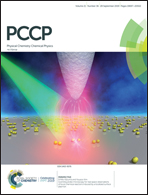Morphologies of a polyelectrolyte brush grafted onto a cubic colloid in the presence of trivalent ions
Abstract
We study the morphologies of a polyelectrolyte brush grafted onto a surface of cubic geometry under good solvent conditions in the presence of trivalent counterions, using molecular dynamics simulations. The electrostatic correlation effect and excluded volume effect on the morphologies are studied through varying the charge fraction and grafting density, respectively. Combining snapshots of surface morphologies, brush height, distribution profiles of polymer monomers, and monomer–monomer/counterion pair correlation functions, it is clearly shown that the electrostatic correlation effect, represented by the trivalent–counterion-mediated bridging effect, can induce lateral microphase separation of the cubic polyelectrolyte brush, resulting in the formation of pinned patches. These structures then lead to multi-scale ordering in the brush system and, thereby, a non-monotonic dependence of the brush height, corresponding to a collapse-to-swell transition, on the grafting density. Our simulation results demonstrate that, with the sequence of surface morphologies responsive to adjusting external parameters, the cubic polyelectrolyte brush can serve as a candidate system for the manufacturing of smart stimuli-responsive materials.



 Please wait while we load your content...
Please wait while we load your content...